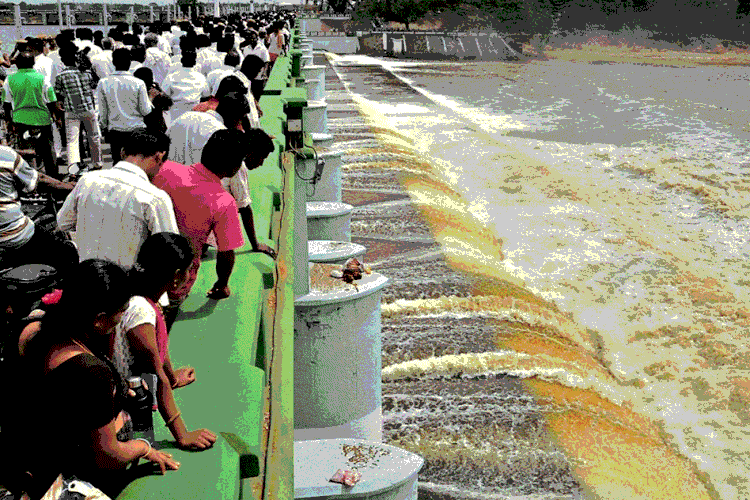Miss Alone
Prime VIP
Despite Cauvery Water Dispute, Bengaluru Wastes Nearly 50% Of The Water It Receives From The River

While Karnataka is locked horns with its neighbour Tamil Nadu in its legal battle for the distribution of water from Cauvery river, a grim picture can be seen within the state.
According to a recent analysis of water data by IndiaSpend, the state’s capital — Bengaluru — which is almost entirely dependent on the river, wastes 50 percent of the water it receives.
The only Indian city that wastes water at a greater rate is Kolkata.
Bengaluru, with a population of 8.5 million, is the third most populous city in India. Everyone should get 150 ltr of water per day. But they get only 65 ltr, which is equivalent to four toilet flushes. The situation is likely to worsen for the city.
The city’s water demand is likely to rise more than three times in the next nine years.
According to the data of Bengaluru Water Supply and Sewerage Board (BWSSB), Bengaluru’s population density is 13 times higher than Karnataka’s average, Bengaluru consumes 50% of Cauvery water reserved for domestic use in Karnataka. As much as 49% of this water supplied is what is called “non-revenue water” or “unaccounted for water”, i.e.., water lost in distribution.
Bengaluru’s water loss is the second-highest among Indian metros: Kolkata leads at 50 percent. The wastage figure for Mumbai is 18 percent, New Delhi, 26 per cent and Chennai, 20 per cent. Across the world, cities lose only about 15 to 20 percent of their supply, said the ISEC study, which pegged Bengaluru’s losses at 48 percent three years ago.
Of the 270 thousand million cubic ft (TMC) of Cauvery water allotted to Karnataka by the Cauvery Water Disputes Tribunal, roughly, about 80 percent is used for agriculture and industry (down from over 90 percent in 2007). This leaves about 20 percent for rural and urban domestic use, of which Bengaluru records the highest demand.
The city receives about 19 TMC of Cauvery water. Recently, the Karnataka State Urban Development Department provisionally raised supply by an additional 10 TMC to meet the needs of 110 villages added to the metropolitan area in 2007. A formal proposal to raise the city’s water supply to 30 TMC from the Cauvery basin has been forwarded to the central government.
Sourced from a distance of 100 km, up to a height of 540 m, the BWSSB spends nearly 60 percent of its budget in pumping water to the Bengaluru metropolitan region. With groundwater reserves overexploited and polluted, and its other two ageing reservoirs – the 120-year-old Heseraghatta and 83-year-old Thippegondanahalli of Cauvery’s Arkavathi tributary – unreliable, Bengaluru is almost entirely dependent on the disputed river.
By 2031, Bengaluru’s water supply will reach its optimum level (2,070 MLD) and stay there while the city’s water demands rise further in the decades thereafter, widening the shortfall progressively, showed BWSSB data.

While Karnataka is locked horns with its neighbour Tamil Nadu in its legal battle for the distribution of water from Cauvery river, a grim picture can be seen within the state.
According to a recent analysis of water data by IndiaSpend, the state’s capital — Bengaluru — which is almost entirely dependent on the river, wastes 50 percent of the water it receives.
The only Indian city that wastes water at a greater rate is Kolkata.
Bengaluru, with a population of 8.5 million, is the third most populous city in India. Everyone should get 150 ltr of water per day. But they get only 65 ltr, which is equivalent to four toilet flushes. The situation is likely to worsen for the city.
The city’s water demand is likely to rise more than three times in the next nine years.
According to the data of Bengaluru Water Supply and Sewerage Board (BWSSB), Bengaluru’s population density is 13 times higher than Karnataka’s average, Bengaluru consumes 50% of Cauvery water reserved for domestic use in Karnataka. As much as 49% of this water supplied is what is called “non-revenue water” or “unaccounted for water”, i.e.., water lost in distribution.
Bengaluru’s water loss is the second-highest among Indian metros: Kolkata leads at 50 percent. The wastage figure for Mumbai is 18 percent, New Delhi, 26 per cent and Chennai, 20 per cent. Across the world, cities lose only about 15 to 20 percent of their supply, said the ISEC study, which pegged Bengaluru’s losses at 48 percent three years ago.
Of the 270 thousand million cubic ft (TMC) of Cauvery water allotted to Karnataka by the Cauvery Water Disputes Tribunal, roughly, about 80 percent is used for agriculture and industry (down from over 90 percent in 2007). This leaves about 20 percent for rural and urban domestic use, of which Bengaluru records the highest demand.
The city receives about 19 TMC of Cauvery water. Recently, the Karnataka State Urban Development Department provisionally raised supply by an additional 10 TMC to meet the needs of 110 villages added to the metropolitan area in 2007. A formal proposal to raise the city’s water supply to 30 TMC from the Cauvery basin has been forwarded to the central government.
Sourced from a distance of 100 km, up to a height of 540 m, the BWSSB spends nearly 60 percent of its budget in pumping water to the Bengaluru metropolitan region. With groundwater reserves overexploited and polluted, and its other two ageing reservoirs – the 120-year-old Heseraghatta and 83-year-old Thippegondanahalli of Cauvery’s Arkavathi tributary – unreliable, Bengaluru is almost entirely dependent on the disputed river.
By 2031, Bengaluru’s water supply will reach its optimum level (2,070 MLD) and stay there while the city’s water demands rise further in the decades thereafter, widening the shortfall progressively, showed BWSSB data.
